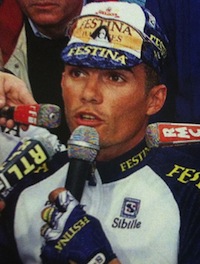 Ah—what a day. Floyd Landis retires, and immediately thereafter, a boatload of not-entirely-unfamiliar looking allegations against Lance Armstrong drop.
Ah—what a day. Floyd Landis retires, and immediately thereafter, a boatload of not-entirely-unfamiliar looking allegations against Lance Armstrong drop.
Looks like the real sporting press scooped their cycling-specific counterparts once again on today’s headlines (with one exception), but at least we’ve got BikeRadar, hard at work bringing us “Profile: Ben Coates“. My journo slang’s a bit rusty, but I’m pretty sure the term for that is a “wet kiss”.
A lot of people got a good, hearty kick out of CycleSport’s repriting of an email from TEAM LEoPARD/Trek that attempted to “guide” the media on styling the team’s name. But it shouldn’t take more than the first few lines of that Coates piece to realize that the Trek representative who sent that was dead serious—some companies’ influence extends well beyond ad income.
Big manufacturers are an all-too-frequent destination for a disturbing percentage of the staff at certain American cycling publications—and even I’ll admit to hesitating a bit before showing spine in the face of a future employer. I suppose you might consider the whims of advertisers something of a litmus test, with a publication’s editorial integrity being inversely proportional to their willingness to accept such requests.
Anyway—the latest Armstrong allegations. After much heralding, “the SI
article” is finally out in full, though the most ravenous Lance-hunters are going to be disappointed. In fact, it’s the USOC, Don Catlin, and a decidedly soft approach to dope test enforcement who come out looking the worst.
That said, there are a lot of new spins on pre-tread stories and sources about Armstrong’s alleged PED use. Mike Anderson, for example, who settled with Armstrong over undelivered funding for a bike shop and/or drugs in Girona, talks about cooking up elaborate ruses to trick unannounced testers.
 Stephen Swart and Landis, who’ve each talked about Armstrong and doping in the past, add new and interesting allegations. While they make pre-cancer Armstrong seem like a longer-term doper and a less-good rider (many others later vanquished by the Texan were apparently tooling on him with roughly equivalent hematocrit levels in the mid-90s), they don’t exactly hammer in any coffin nails.
Stephen Swart and Landis, who’ve each talked about Armstrong and doping in the past, add new and interesting allegations. While they make pre-cancer Armstrong seem like a longer-term doper and a less-good rider (many others later vanquished by the Texan were apparently tooling on him with roughly equivalent hematocrit levels in the mid-90s), they don’t exactly hammer in any coffin nails.
In fact, when one takes them in concert with the prior testimony of Emma O’Reilly, Swart’s latest allegations are downright incongruous. If Armstrong was racing at a hematocrit in the mid-50s in 1995 (roughly in line with the Festina Team’s self-imposed and somewhat ridiculed limit), I find it very hard to believe Armstrong would let himself slide down to a mere 41 three years later. For that matter, given EPO’s near-legendary efficacy, I can’t imagine he’d be at all concerned about catching back up.
Similarly, those seeking the Texan’s scalp will find no smoking guns in a report that two of Armstrong’s on the 1990 US Junior Team claim they were given drugs by coaches. Unless I’m mistaken, this refers to the case brought by Greg Strock and Erich Kaiter. While their trial was covered by Velonews back in 2006, the magazine apparently never followed up—the only other appearance of Strock’s name on the VN website is in results from the 2009 Tour of Elk Grove.
That leaves us with three—(or is it four?)—new, disturbing, but still not damning tidbits. One: that Popovych and Team RadioShack (though not necessarily Lance Armstrong) were in contact and under the advisement of Dr. Michele Ferrari, at least as recently as 2009. This is well after Armstrong claims to have cut ties with the not-so-good doctor for, you know, appearances—because the Texan maintains the Italian wasn’t ever helping him dope.
Two: Armstrong at least had obtained “access” to HemAssist, an artificial oxygen carrier similar that reported to have been in Michael Rasmussen’s shoebox in 2002. While FDA trials ended in 1998, enough was around for studies in 2002 and 2004.
Three (and perhaps most alarming of all): the lab of Don Catlin, a pioneer in the scientific fight against doping, appears to have made some serious clerical errors in the handling of samples belonging to Armstrong between 1990 and 2000.
While none of the roughly 24 tests taken in that window drew a doping sanction, the records of five have simply vanished. Of the remainder, three tests were recorded as initially having T:E ratios well outside the legal range, though somewhat improbably, two of them failed to return positive results in a confirmation test; the “father of drug testing in sport” has yet to say anything about the third.
I suppose we’ll all know more about this tomorrow when the magazine actually hits newsstands The full article is now live. And there may be further developments, as I’m told some elements of the story threatened to bring too much heat for Sports Illustrated‘s editor to take, and might have to find their way to the public through a different route.
The mushrooms at CNF must be having a field day as they have been hanging on this article to be printed with bated breath.
Accused me of being immature to ask for Lance to be judged in a court of LAW instead of being tried by their supposition & innuendo.
Today also there was a report on the negative effects of Sports Personalities on advertising campaigns , Tiger Woods was more negative than Lance and these were the guys judged the best from the last decade.
Regardless of the smearing i hope that “Livestrong” continues with helping Cancer Sufferers to find the help they need
if public perception finally swings out of lances favor, does that mean Cancer is making a comeback?